Brief History of Lake Apopka
Historically, Lake Apopka, Florida was a premier tourist destination, but more recent environmental degradation led to a decline in water quality and subsequent restoration efforts. Lake Apopka in central Florida (Figure 1) is the state’s fourth largest lake (124 km2) and was formerly a clear-water macrophyte-dominated clastic (composed of consolidated sediments) lake. The lake transitioned to a eutrophic state (i.e., so enriched with nutrients that decomposition of plants leads to low oxygen and impaired habitat) due to marsh loss, agricultural inputs, wastewater discharges, and other stresses (Conrow et al. 2011). Research on Lake Apopka has highlighted the rapid eutrophication, the potential for restoration, and restoration progress and setbacks, with a focus on nutrient removal and planting vegetation to facilitate recovery (Dunne et al. 2015; Dunne et al. 2012; Slagle and Allen 2018). More recent work has examined the best ways to maximize successful plantings and restoration efforts for submersed aquatic vegetation (SAV) (Reynolds et al. 2021; Rohal et al. 2020a) and utilization of SAV by fish (Looby, Reynolds, Adams, and Martin 2021; Looby, Reynolds, Adams, Walsh, et al. 2021). General interest in the habitats and plant communities of Lake Apopka is the result of increased public access and enthusiasm for improving these habitats for recreation, and therefore there is considerable interest in the lake’s plant community.
This publication profiles common wetland and aquatic plants of Lake Apopka. The intended audience is the public and natural resource professionals with an interest in the common flora of this region. For more detailed information on identification of a broader set of aquatic plants, consult the UF/IFAS Center for Aquatic and Invasive Plants Directory (https://plants.ifas.ufl.edu/plant-directory/) and Identification and Biology of Nonnative Plants in Florida's Natural Areas, 2nd Ed. by K. A. Langeland, H. M. Cherry, C. M. McCormick, and K. A. Craddock Burks (2008), which is available from the UF/IFAS Extension Bookstore (http://ifasbooks.ifas.ufl.edu). More detail on habitat types can be found in the Florida Natural Community Classification Guide (Florida Natural Areas Inventory [FNAI], 2010). Several EDIS publications also complement this publication, some with more detail on native wetland plants (e.g., Moore et al. 2015), and others covering topics including invasive species terminology (Iannone et al. 2021), a guide to nonnative plant lists (Lieurance and Gettys 2019), native wetland and aquatic plant biology (e.g., Rohal et al. 2020b; Tootoonchi et al. 2019), and SAV planting techniques (Reynolds et al. 2020). Bolded botanical terms are defined in a glossary at the end of this document.
Restoration and Recreation
After decades of water quality degradation and associated decline of fisheries in Lake Apopka, restoration efforts have contributed to habitat improvement within the lake. Actions include establishment of a marsh flow way that removes nutrient-rich sediment (Dunne et al. 2012), restoration of surrounding marshes (Bowen and Slater 2016), and reductions in nutrient inputs (Coveney et al. 2005), all of which have contributed to long-term improvements in water quality (Ji and Havens 2019). Subsequently, characteristic aquatic plants have returned to Lake Apopka, via both natural colonization and planting; their persistence is a sign of habitat recovery, but also these plants will help consolidate floating suspended sediments, sequester nutrients and continue to improve water quality. Habitat restoration and the wildlife that benefit from these improvements have again made Lake Apopka a recreation destination for boating, fishing, hiking, biking, bird-watching, and wildlife photography.
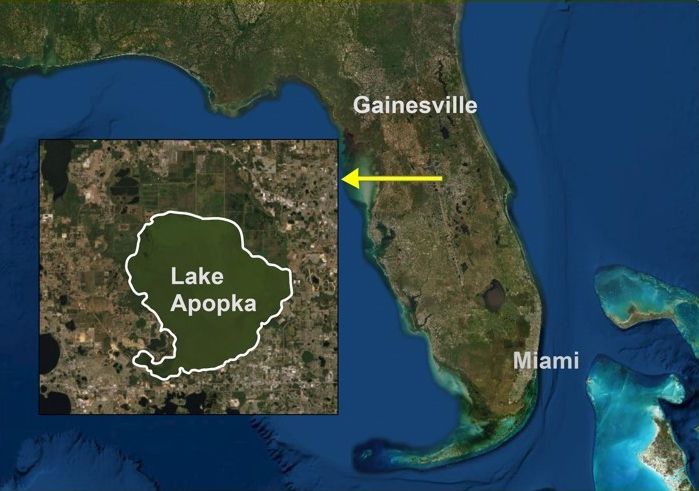
Importance of Aquatic Plants
A major emphasis for restoration of Lake Apopka is the reestablishment of desired wetland and aquatic plant communities within the lake. Plants are essential to the ecology of all Florida lakes and wetlands, including Lake Apopka, and allow for shoreline and bottom sediment stabilization, improved water clarity, and habitat for wildlife. Wetland plants also perform important functions, including providing habitat, abating the effects of flooding, and improving water quality.
While in general plants provide beneficial functions, some species can create problems such as habitat change or access limitations. Nonnative species can be particularly problematic nuisance species, and even some native species with high growth rates can in some situations turn into nuisance species. Nuisance species can suppress other desired plant species, create undesirable lake conditions, impede navigation, and limit recreational activities. In part due to elevated nutrients and other sources of degradation, Lake Apopka harbors some of these nuisance species that can limit desirable vegetation and other functions and are therefore the focus of plant management efforts.
The common plants of Lake Apopka, with descriptions and management context, are profiled here according to the type of aquatic plant: (1) shrubs that colonize terrestrial brush and higher elevation features; (2) emergent wetland plants that occur along the shoreline and shallower zone of the lake; (3) submersed aquatic plants that occur in deeper zones, are rooted to the lake bottom, and remain mostly beneath the water surface; and (4) floating plants that utilize leaves that float on the water surface and may or may not be rooted in sediment.
Document Goals
This document serves as a tool to acquaint the public and natural resource professionals with knowledge of the common flora of this region of interest. The species profiled include the most dominant characteristic species according to natural community descriptions (Florida Natural Areas Inventory [FNAI] 2010) and species that are common according to data from citizen volunteer lake monitoring from 2006 to 2010 in Lake Apopka (UF/IFAS Lakewatch Program 2020), from vegetation perimeter surveys by St. Johns River Water Management District from 2012 to 2017, and from our observations from 2019 to 2021. We provide identification tips, cultural relevance, and management issues. A more complete list of plants detected in Lake Apopka is provided in Table 1.
Profiles of Common Plants
These profiles describe common plants of Lake Apopka. Information on each species has been combined from selected databases (UF/IFAS Center for Aquatic and Invasive Plants 2021; USDA, NRCS 2018). Notes on occurrence in Lake Apopka draw on information from historical accounts (Chesnut and Barman 1974; Clugston 1963) and more recent surveys (Murphy 2005; UF/IFAS Lakewatch Program 2020). Profiles include both native species (evolved in this geographic location) and nonnative species (did not evolve in this geographic location) and state the nuisance status of each species (Iannone et al. 2021). Invasive plants (nonnative introduced species that cause ecological harm), as classified by the Florida Invasive Species Council (FISC 2019) and regulated by the Florida State and Federal Noxious Weed Lists (Florida Department of Agriculture and Consumer Services, Division of Plant Industry 2022 and United States Government Publishing Office 1975), are noted in the text and Table 1.
Shrubs
Shrubs often line aquatic features and occupy terrestrial brush, higher elevations, or drained areas of marshes. When water levels are low, shrubs may increase in cover and provide habitat for many species of marsh and perching birds, but they can also persist in fire-deprived areas and suppress other desirable vegetation. Drought and low lake levels can result in problematic encroachment of shrubs into formerly open water and emergent marsh, reducing habitat quality.
Coastal plain willow (Salix caroliniana)
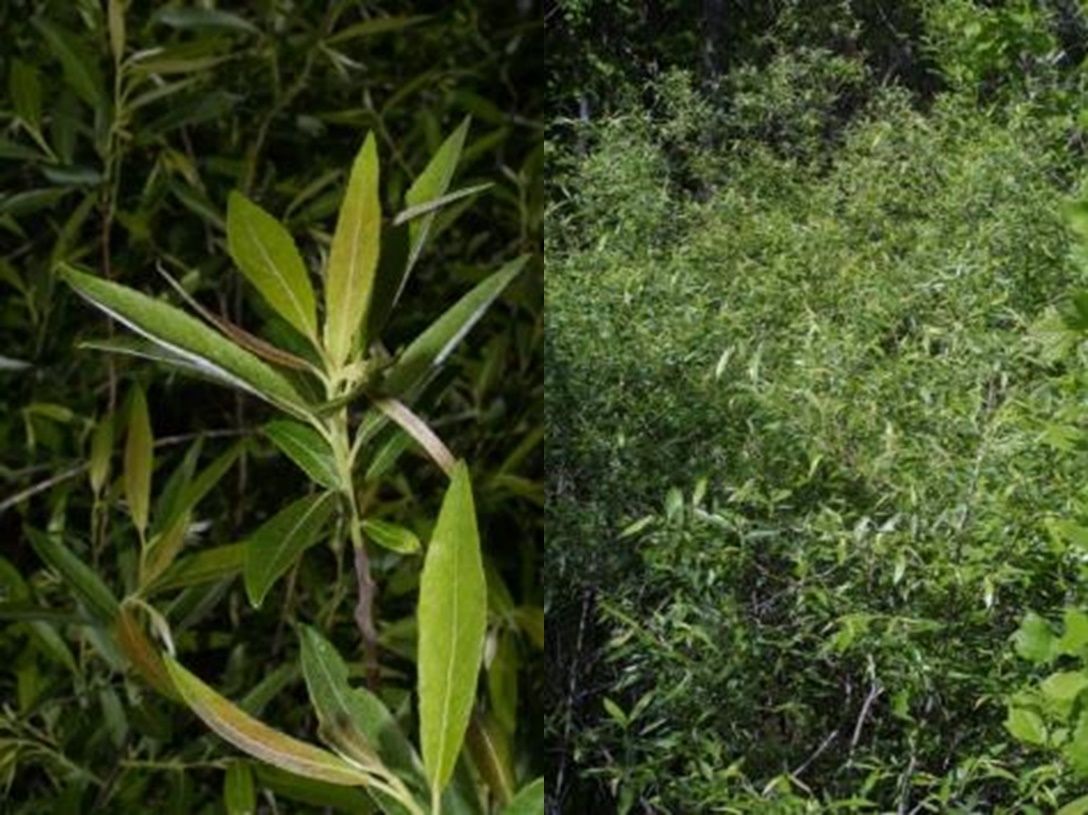
Credit: Steven J. Baskauf, http://bioimages.vanderbilt.edu/
Willow is a large shrub, growing 15–30 ft in height with a spreading, open, irregular crown and short, often leaning, trunks. This shrub is often as broad as it is tall and common in many wet thickets and swamps throughout Florida and much of the eastern and central United States. It provides significant food and cover for wildlife. For instance, it is a larval host plant for viceroy butterflies (Limenitis archippus). Willow is a dominant shrub on the higher ground shoreline of Lake Apopka. Although this species is native and characteristic of the ecosystem, it can be more prevalent in areas of disturbance, occupy former open water areas, outcompete other desirable plants, and become a nuisance.
Elderberry (Sambucus nigra subsp. canadensis)

Credit: Vic Ramey and Ann Murray, UF/IFAS Center for Aquatic and Invasive Plants
Elderberry is a large, branched shrub native to Florida that typically grows 10 ft or more and produces blue-black berries that are toxic when raw. Leaves are arranged oppositely on the stem, and each leaf consists of 5 to 11 leaflets. Fragrant white flowers produce large clusters (2–10 inches across) throughout spring and fall. Many wetland plants with large white clusters of flowers (including some that are edible) are easily confused with elderberry; therefore, to prevent ingesting toxins, it is best to avoid all aquatic plants with large clusters of white flowers. Elderberry is a dominant shrub on the higher elevation shoreline of Lake Apopka. Although this species is native and characteristic of the ecosystem, it can be more prevalent in areas of drainage and disturbance, replacing other more desirable plants and becoming a nuisance.
Saltbush (Baccharis hamilifolia)
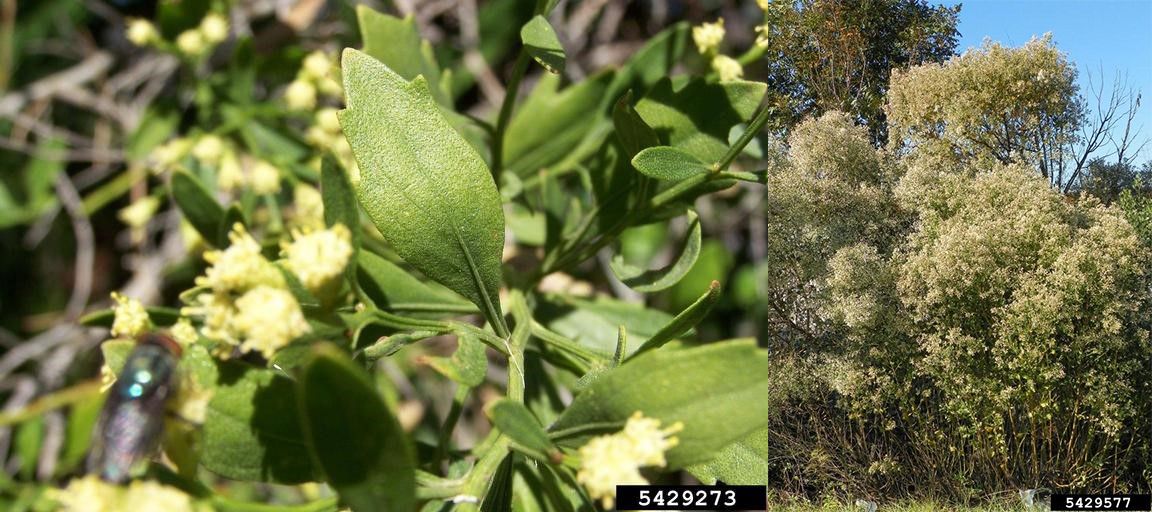
Credit: Karan A. Rawlins, University of Georgia, Bugwood.org
Saltbush is a native, salt-tolerant plant found on beaches, marshes, and disturbed areas throughout Florida. Saltbush grows as a perennial shrub up to 10 feet tall with dark-green leaves alternatively arranged on its stems. The leaves are thick and egg-shaped, and they have smooth or coarsely toothed margins. At the tips of stems are stalked clusters of white, cotton-like flower heads with small fruits that are dispersed by the wind. Because saltbush can grow in dense clusters, it may become weedy. However, it can be beneficial to wildlife by providing shelter and nesting sites to birds.
Buttonbush (Cephalanthus occidentalis)
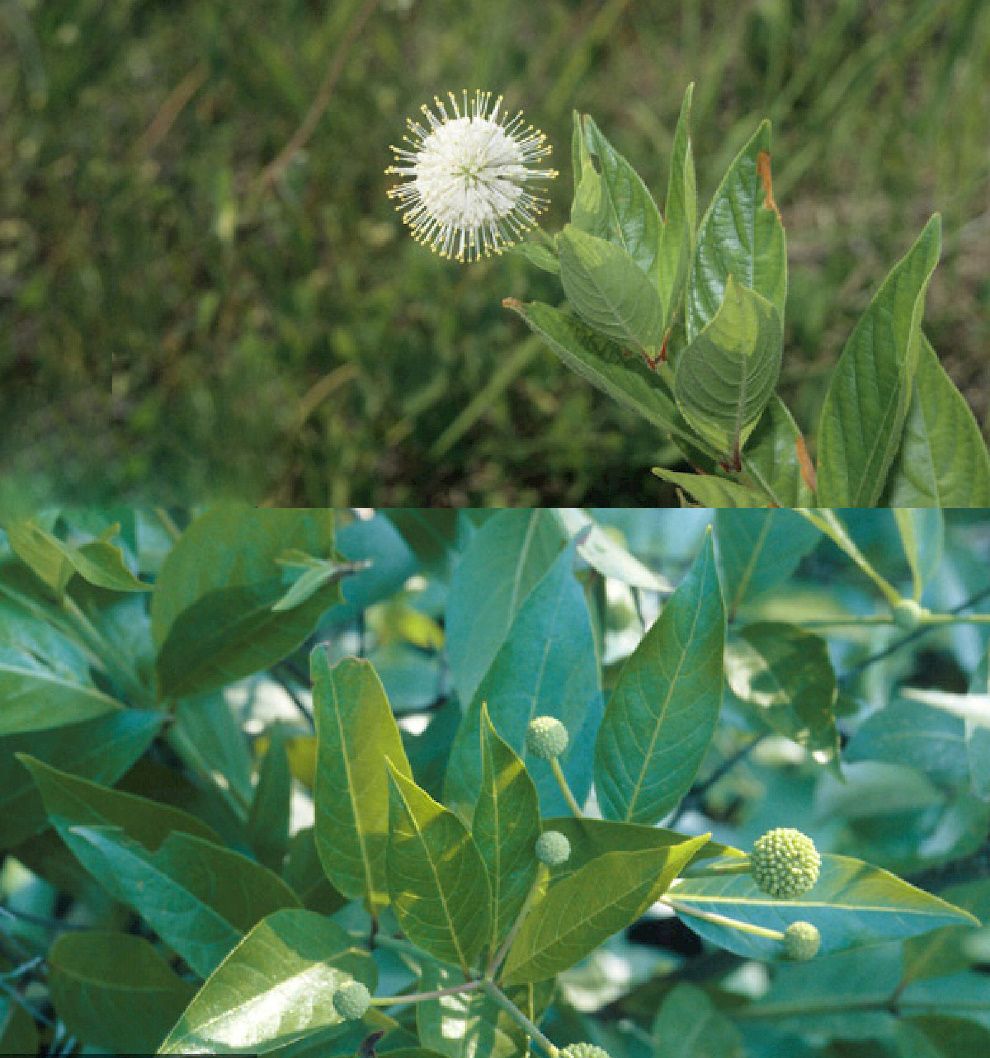
Credit: Vic Ramey and Ann Murray, UF/IFAS Center for Aquatic and Invasive Plants
Buttonbush is a native-to-Florida perennial species that grows as a shrub or small tree up to 20 feet tall. It flowers from early spring to late summer, producing small white flowers arranged in ball-like clusters at the ends of branches. The flower balls surround dense round fruits and can be over an inch in diameter. Arranged oppositely on the stems are tapered, pointed leaves two to six inches in length. Buttonbush seeds are a source of food for waterfowl and shorebirds, and its structure is used for shelter by nesting wood ducks. In addition, the dense stands it forms make this plant useful for erosion control along shorelines. Buttonbush is a common wetland shrub throughout Florida and a prominent shore species at Lake Apopka.
Emergent Wetland Plants
Emergent wetland plants are located in water-saturated areas throughout marshes and near lake shorelines; in Lake Apopka, emergent plants grow from the water’s edge to a depth of 3 to 6 feet. Although the leaves and stems of these plants are usually the only vegetation visible above the water line, survival is possible during periods of low water in exposed and damp sediment. Fluctuation of water levels can create different flooding conditions that shift zones and plant communities, such that emergent plant abundance is decreased during times of sustained high or low water levels. Emergent plants are responsible for several functions, including shoreline stabilization, wildlife habitat, and organic matter addition to sediment through shed leaves and other debris. Management of emergent species is sometimes required when large stands of plants create navigational hazards.
Alligatorweed (Alternanthera philoxeroides)
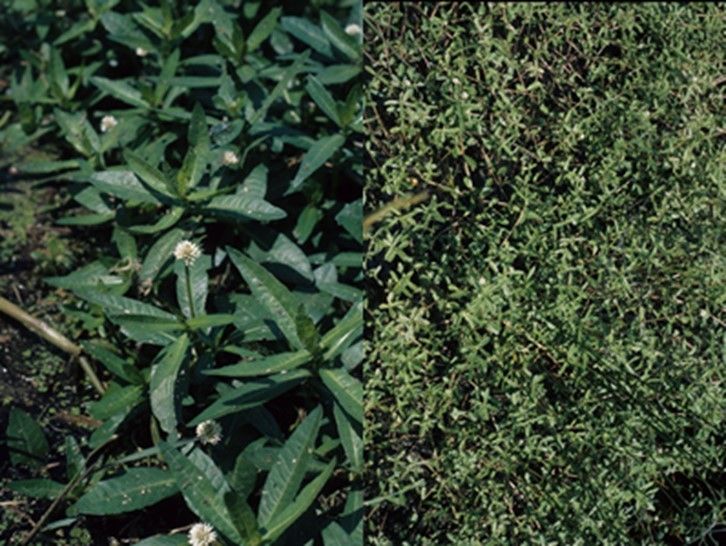
Credit: Vic Ramey, UF/IFAS Center for Aquatic and Invasive Plants
Alligatorweed is not native to Florida but was introduced from South America and began invading Florida waterways in the early 1900s; now this perennial herb is common throughout the state and is present in some areas of Lake Apopka. Alligatorweed has smooth stems that trail along the ground or across the water’s surface and distinctive white flower clusters that bloom in summer months. This species forms dense floating mats over deep water and edges of waterbodies, which can block drains and water intake valves, limit light availability, and displace native species. Introduced biological control agents (Center et al. 2022; Wells and Minteer 2022) effectively reduce alligatorweed in much of its range for open water conditions, but not in swampy or terrestrial scenarios. Alligatorweed is regulated because it appears on the State Noxious Weed list (unlawful to introduce, multiply, possess or transport) and is classified as a Category II invasive, meaning that it has increased in abundance or frequency, yet alteration of Florida plant communities is not as extensive as with Category I species (FISC 2019), so control on Lake Apopka is secondary to that for other more impactful invaders.
Cattail (Typha domingensis, Typha latifolia, and hybrids)
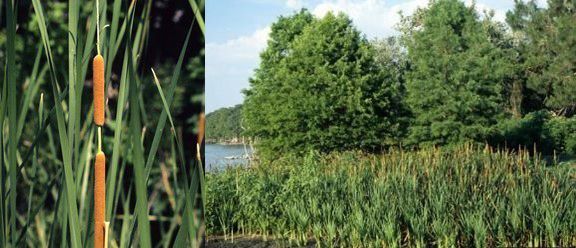
Credit: Ann Murray, UF/IFAS Center for Aquatic and Invasive Plants
Cattails are an upright, perennial species that can create large monodominant stands. There are two Florida native species (Typha domingensis, southern cattail, and Typha latifolia, common cattail) that share many characteristics and likely hybridize, so it is difficult to confirm their identity without genetic testing. Leaf stalks emerge from rhizomes (underground stems) below the soil surface and produce long, tapered leaves with smooth margins. Getting their name from their large cylindrical flower spikes, they are not often mistaken for other species. The densely packed flower spikes include a narrower upper portion containing male flowers and a wider base of female flowers. Leaves from the bottom half of cattails appear straight but begin to twist and spiral in the top half of the plant. Cattails are known for their phosphorus retention potential and grow well in high nutrient conditions such as Lake Apopka. Providing benefits such as nesting habitat and protective cover for wildlife, cattails do require management action when monocultures get too dense and expansive and reduce habitat by outcompeting other desirable plants.
Common Arrowhead (Sagittaria latifolia)

Credit: Vic Ramey and Ann Murray, UF/IFAS Center for Aquatic and Invasive Plants
There are several Sagittaria species native to Florida, mainly referred to as arrowheads. Sagittaria latifolia is known as common arrowhead due to its frequent presence and distribution in wetland habitats. This aquatic perennial gets its name from the large arrowhead-shaped leaves that can be up to 8 inches wide and over a foot long. When present, a flowering scape can include as many as 10 whorls with three-petaled white flowers. These flowers are very similar to other Sagittaria species. Reproduction can be achieved either through rhizomes or seeds. This beneficial plant seldom creates problems for lake managers and is considered a very valuable food source to wildlife. Tubers and seeds can be consumed by waterfowl and help attract native birds to Lake Apopka, where this species commonly co-occurs with pickerelweed and duck potato.
Cuban Bulrush (Cyperus blepharoleptos)

Credit: Ann Murray, UF/IFAS Center for Aquatic and Invasive Plants
Cuban bulrush is a nonnative plant common to the freshwater marshes of north and central Florida. The stems of this sedge can reach 3 feet in height and are smooth and triangular with many long, narrow (about ¼ inch wide and 3 to 4 feet long) leaves growing from the base. From the tip of the stem grows an inflorescence of stalks surrounded by long leaflike bracts. Each stalk of the inflorescence holds a dense spherical head of reddish-brown spikelets. Cuban bulrush spreads by rhizomes to form large colonies, which may float on the surface of slow-moving water. These floating mats pose a risk to other emergent plant species, which may be crowded out or excluded. Cuban bulrush is known to be “aggressively weedy” in Georgia and Alabama and may be becoming more present in Florida.
Giant Bulrush (Schoenoplectus californicus)
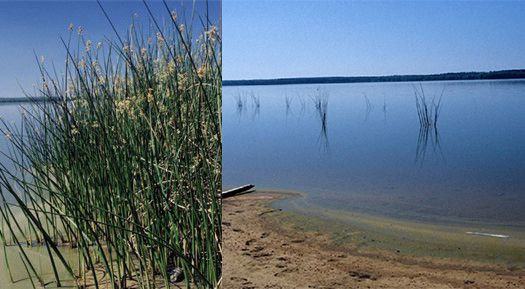
Credit: Vic Ramey and Anne Murray, UF/IFAS Center for Aquatic and Invasive Plants
Giant bulrush is a native plant often seen growing along banks or in several feet of water along the shores of Lake Apopka. This species reaches 10 feet or taller and is an emergent plant but can be found in deeper water, up to 3 feet. Giant bulrush is recognizable by its tassel-like flower spike with irregular drooping branches at the pinnacle of the tall stem with no leaf blades. It blooms from spring to summer, with the brown spikelets contrasting against the smooth, dark-green stems. Flowers are wind pollinated and eventually create a long red-brown seed. Along with seed dispersal, giant bulrush can aggressively reproduce via rhizomes below the surface. This rush is known for its high wind resistance and lakeshore stabilization. Seeds are utilized by waterfowl as an important food source, and the structure of the stems provides important cover for birds and other wildlife. Because of all the benefits provided by giant bulrush, this species is actively planted in Lake Apopka and is typically not a nuisance.
Lance-Leaved Duck Potato (Sagittaria lancifolia)

Credit: Ann Murray and Vic Ramey, UF/IFAS Center for Aquatic and Invasive Plants
Another Sagittaria species, lance-leaved duck potato is the largest of the arrowheads and is frequently observed along the shoreline of Lake Apopka, forming critical habitat and rarely becoming a nuisance. Leaves on the duck potato are typically four inches wide and up to two feet long. These leaves are tapered near the stem and grow as a rosette from rhizomes. The name “duck potato” is derived from large bulbous stem parts (corms) growing underground. White flowers are seen above leafy vegetation with petals in whorls of three. Fruiting heads are composed of hooked seeds that readily attach to fur or feathers for an effective dispersal system. Despite the common name of this plant, ducks do not eat the corms, yet humans have used them as a food source for centuries. Though waterfowl do sometimes consume seeds, duck potato is not generally considered an important food source for them. However, the large leaves and firm stems of this species offer an ideal substrate for the attachment of apple snail eggs, an important food source for birds like limpkins and kite species.
Maidencane (Panicum hemitomon)
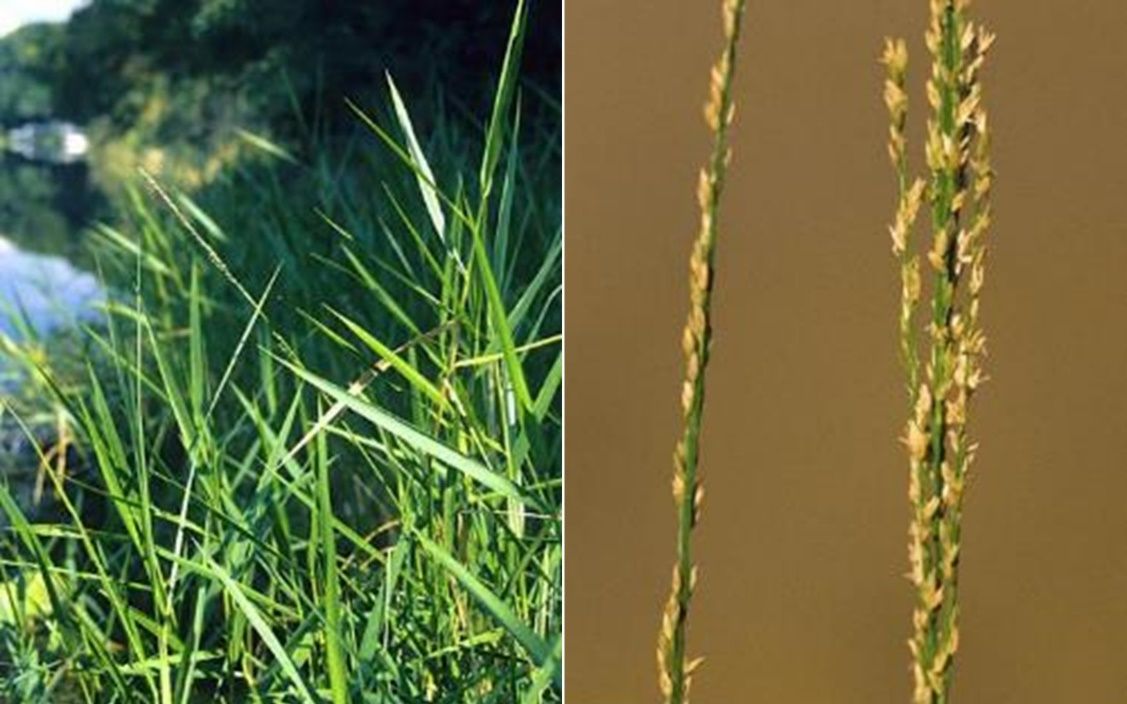
Credit: Vic Ramey and Ann Murray, UF/IFAS Center for Aquatic and Invasive Plants
Maidencane is a native grass with tall narrow stems and an extensive root system. It grows in moist soil but can also grow in relatively dry soils above the water line. The stems can reach 6 feet in length and contain flat or folded leaves that grow to one inch wide and a foot long. The points of these leaves are generally smooth. The inflorescence is a very narrow spike-like panicle, containing green flowers up to 1/8 inch pressed against the branches. Dispersal methods for maidencane are either vegetatively through rhizomes or through seed production. This is an essential species to Lake Apopka, because it is an important aquatic plant for fish management. Adding cover and spawning habitat to the shallow shoreline, maidencane creates great habitat around its roots. From a land management perspective, this grass is generally not a problem unless dense mats cause navigation and recreation problems, which can be reduced with herbicide.
Para grass (Urochloa mutica)

Credit: Vic Ramey, UF/IFAS Center for Aquatic and Invasive Plants and Forest & Kim Starr (left); CC BY 3.0 , via Wikimedia Commons (right)
Para grass is a nonnative perennial species that was first introduced to the United States as a forage plant for livestock. It is now distributed throughout south, central, and northeast Florida and can be found in some areas of Lake Apopka. Para grass grows stems up to eight feet tall from long creeping stolons growing horizontally above soil. The stem has hairy nodes and sheaths, and its leaves are long and narrow (4–12 inches long, ½ inch wide). At the tip of the stem is the inflorescence as a branched panicle. Along the panicle branches are many small spikelets with inconspicuous purplish flowers. Para grass spreads aggressively by creeping stolons, cuttings, and seed, and it can form large, fast-growing colonies that crowd out native plants. Floating mats formed in drainage ditches or irrigation canals impede water flow and restrict the navigational and recreational usage of waterways. Para grass is classified as a category I invasive species, meaning that it alters native plant communities by displacing native species, causing considerable ecological damage (FISC 2019).
Pickerelweed (Pontederia cordata)
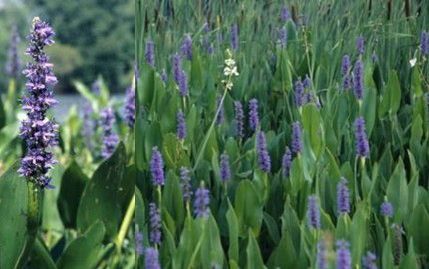
Credit: Ann Murray and Vic Ramey, UF/IFAS Center for Aquatic and Invasive Plants
Pickerelweed is a common Florida native species that flowers yearlong. Recognizable by its lance-shaped leaves, this species grows abundantly and thus can cover large areas. Pickerelweed typically grows 2–3 feet in height and has large leaves measuring up to 5 inches wide and twice that length. Although leaf shape is variable, typical foliage is the shape of an arrowhead, which is why it is often confused with Sagittaria latifolia (common arrowhead). The main distinguishing feature of pickerelweed is its large spike of violet-blue flowers. On nonflowering plants, to tell the difference between pickerelweed and common arrowhead, one must look at the leaf lobes. Lobes of pickerelweed are rounded and heart-shaped as opposed to the pointed lobes of common arrowhead. Depending on density of pickerelweed stands, water birds and small mammals can use this species as a staple of their diet and cover. This beneficial plant is easily visible on the shores of Lake Apopka and does not typically pose a nuisance.
Torpedograss (Panicum repens)

Credit: Ann Murray, UF/IFAS Center for Aquatic and Invasive Plants
First introduced as a forage crop for cattle, torpedograss is now a widespread invasive in Florida and has been noted to occur in isolated stands of aquatic grasses at Lake Apopka. This nonnative grass is found on marshy shorelines and readily invades disturbed or open areas. Torpedograss is named for the sharply pointed growing tips that emerge from rhizomes in the mud. These growing tips become stems up to 40 inches tall with short and flat or folded leaves. Torpedograss leaves have hairs on the upper margins and sheaths and often a whitish, waxy coating on the surface. At the tip of the stem is the inflorescence, which is a branched panicle with straw-colored spikelets. It spreads aggressively by rhizomes and stem fragments, creating large mats that clog waterways and block shorelines. Once established, torpedograss is difficult and expensive to control. Torpedograss is classified as a category I invasive species, meaning that it alters native plant communities by displacing native species, causing considerable ecological damage (FISC 2019).
Wild Taro (Colocasia esculenta)
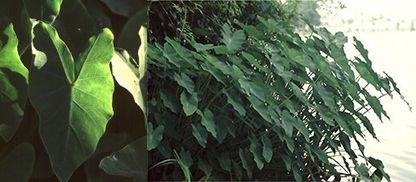
Credit: Vic Ramey, UF/IFAS Center for Aquatic and Invasive Plants
This widespread nonnative species was introduced to Florida by the USDA in 1910 as a substitute crop for potatoes, owing to its production of large underground starchy corms, which are a common food source in Central and South America. This perennial species has long and wide arrowhead-shaped leaves that are velvety on top. Wild taro can be confused with the nonnative elephant ear (Xanthosoma sagittifolium) because of its large elephant-ear-like leaves, yet wild taro differs in that its leaves are peltate, meaning their stalks (or petioles) attach to the lower surface of the leaf and not to the leaf-blade margin. Considered an aggressive weed, wild taro is now found along many Florida waterways and canals and in some areas of Lake Apopka, forming dense stands and displacing native shoreline vegetation. Removal of this species is complicated by the presence of oxalic acid in the leaves, which can cause skin irritation. Wild taro is classified as a Category I invasive species, meaning that it alters native plant communities by displacing native species, causing considerable ecological damage (FISC 2019).
Submersed Aquatic Plants
Plants growing nearly entirely underwater, commonly referred to as submersed aquatic vegetation, or SAV, are either rooted or unrooted below the water line in permanently saturated areas. Because they are fully submersed, factors such as pH, water clarity, light, nutrient availability, and soil stability impact where these species will be found. Ecosystem functions of submersed plants include increasing water clarity, muck and sediment stabilization, catalyzing nutrient cycling, and benefiting wildlife. Submersed vegetation offers ideal habitat, cover, and food for countless aquatic species. While most submersed plants are desirable, depending on management goals and growth rates of vegetation, submersed plant life can become a nuisance to recreation, navigation, and flood control. Management action is assessed and dealt with on a case-by-case basis.
Eelgrass/Tape Grass (Vallisneria americana)
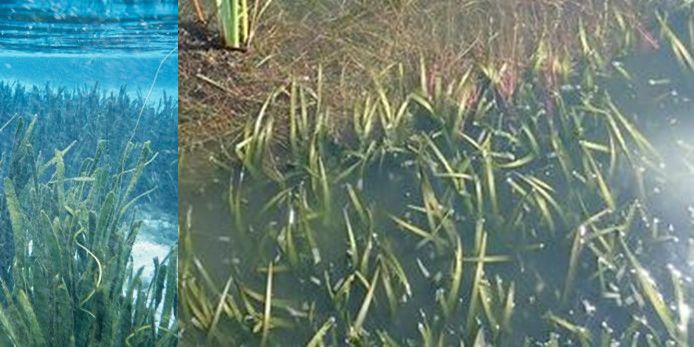
Credit: Christine Rohal (right) and Vic Ramey (left), UF/IFAS Center for Aquatic and Invasive Plants
A submersed plant with ribbonlike leaves, eelgrass is another species currently being used for the revegetation of Lake Apopka. Vallisneria americana grows from underground rhizomes and produces leaves with rounded tips about an inch wide and up to several feet long. Depending on rooting depth, it is not uncommon to see leaves of this species floating across the water’s surface. Flowering for this species occurs in the summer and fall but has been observed during fall, winter, and spring at Lake Apopka. A long slender pedicel will grow from the base of the leaves, carrying a single white tubular “female” (pistillate) flower for surface pollination. There is also an underwater “male” (staminate) flower at the base of the plant, which is not visible from the surface. Once pollen floats to the surface and fertilization is complete, the surficial (female) flower will coil and lower the fruit to the bottom of the lake. Like other fast-growing submersed aquatic plants, eelgrass has the ability to cause water-use problems for boating and fishing, but management action is not often required. Eelgrass is a beneficial species that is a valuable food source for waterfowl, useful for fish habitat (Looby, Reynolds, Adams, and Martin 2021; Looby, Reynolds, Adams, Walsh, et al. 2021) and spawning areas, and the most abundant native submersed aquatic vegetation in Lake Apopka. It is an obvious choice for revegetation projects (Reynolds et al. 2020; Tootoonchi et al. 2019).
Coontail (Ceratophyllum demersum)

Credit: Graves Lovell, Alabama Department of Conservation and Natural Resources, Bugwood.org
Coontail is a native aquatic herb with slender and elongated stems with whorled leaves that is found within Lake Apopka. This species does not have “true roots” and therefore is sometimes considered a free-floating species, but it is able to lodge itself in the sediment with modified leaf structures. Described as looking like a raccoon tail, leaves are feathery and fan-shaped, divided into several narrow segments. The midrib of leaves contains several small teeth, which make coontail rough to the touch. Flowers occur annually but are seldom seen because they are very small and grow on the base of the leaf. Common in calmer streams and lakes, this species is very tolerant of fluctuating water levels and moderate turbidity. Reproduction is either through seeding or fragmentation of the plant. Although it can develop subsurface mats reaching nuisance levels in high-nutrient waters, coontail is generally seen as beneficial to fisheries, because small fish and insects often utilize this species as cover. This species was occasionally detected in surveys of Lake Apopka during 2019 and 2020, with some large areas in sheltered coves.
Hydrilla (Hydrilla verticillata)

Credit: Leslie J. Mehrhoff, University of Connecticut, and Chris Evans, University of Illinois, Bugwood.org
Introduced to Florida in the 1950s through the aquarium trade (from Asia and/or India; there is genetic evidence for two introductions), nonnative hydrilla quickly established itself around the state. Now on the Federal Noxious Weed List, hydrilla can thrive in almost any freshwater habitat, Lake Apopka included. This is a species that can grow at any depth of the lake and can even flourish in 1% of full sunlight. Hydrilla has branching stems that fragment and form dense mats. It can be distinguished from other species by its small, bright-green, pointed leaves with serrated edges; these leaves are less than an inch long and are generally arranged in whorls of 3–8, which are connected to the stem. As a prolific grower, the stem of hydrilla is thin and can grow up to an inch per day. At the base of underground stems, potato-like tubers used for reproduction and food storage are produced. In fact, reproduction for hydrilla is vegetative only via fragmentation, tubers and turions. This species causes many management problems and has to be controlled frequently with herbicides. In some scenarios, hydrilla provides habitat for fish and food for diving ducks. Anglers are particularly interested in this species for “enhanced bass habitat.” However, hydrilla has the potential to rapidly expand, often becoming a hazard to navigation; large populations of hydrilla are common targets of management in Lake Apopka. Proper identification of hydrilla is critical for management; although it has not been detected in Lake Apopka, native elodea (Elodea canadensis) may be mistaken for hydrilla but can be distinguished by its leaves in whorls of 3. Hydrilla is regulated as it appears on the State Noxious Weed list (unlawful to introduce, multiply, possess or transport) and the Federal Noxious Weed List (all interstate movement is prohibited) and is classified as a Category I invasive species, meaning that it alters native plant communities by displacing native species, causing considerable ecological damage (FISC 2019). For more information on hydrilla in Florida, see Enloe et al. (2012) and Gettys and Enloe (2016).
Illinois Pondweed (Potamogeton illinoensis)
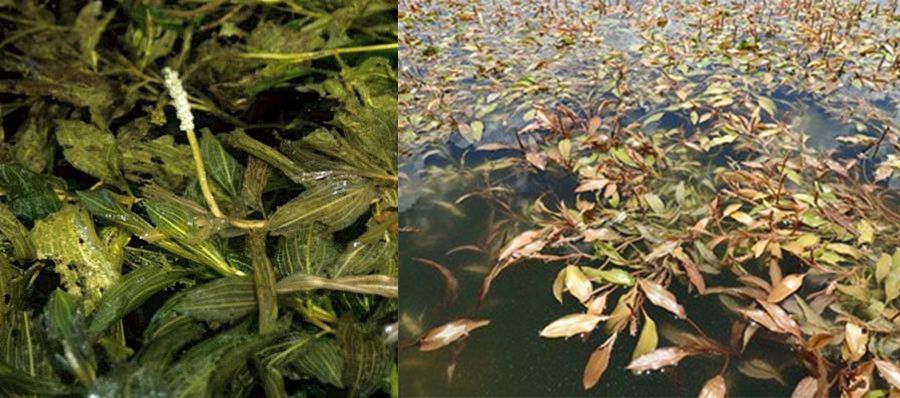
Credit: Vic Ramey, UF/IFAS Center for Aquatic and Invasive Plants and Whitney Scheffel
Commonly referred to as pondweed, Potamogeton illinoensis is a submersed plant growing from a large network of horizontal rhizomes. This native species grows well in shallow areas and is currently being used in restoration/revegetation projects in Lake Apopka. Pondweed can be characterized by its submersed and free-floating leaves that vary in shape; submersed leaves are typically lance-shaped with pointed tips, yet floating leaves have a more elliptical shape. Submersed and floating leaves are more or less the same size (up to 8 inches in length). Sometimes seen sticking above floating leaves, the inflorescence is a vertical spike that is up to three inches long, containing greenish flowers. When not dispersed through seeds, pondweed can reproduce via rhizomes and vegetative fragments, creating a large network of plants. Pondweed further benefits overall aquatic ecosystems by creating cover for fish and an important food source for waterfowl. Though occasionally regarded as a nuisance species due to its rapid growth under specific conditions, pondweed is highly desirable in Lake Apopka. Historical presence in the lake, as well as its promising performance in less-than-ideal conditions, has led pondweed to be selected as a major species for restoration of submersed aquatic habitat. Although naturally colonizing populations of Illinois pondweed have not been recently detected in Lake Apopka, some patches have been established via restoration efforts (Reynolds et al. 2020; Rohal et al. 2020b).
Muskgrass (Chara spp.)

Credit: Vic Ramey and Ann Murray, UF/IFAS Center for Aquatic and Invasive Plants
Several species of Chara are present in Florida, and all grow attached to the bottom of lakes. But muskgrass is not a true higher plant—it is actually a multicellular macroalga. Muskgrass has no leaves, but spines and calcium deposits that make it rough to the touch and give it a grainy texture. Muskgrass is named for its distinctive garlic odor. Found co-occurring with other submersed plants in Lake Apopka, muskgrass has no flower, will not extend above the water surface, and can reproduce rapidly and form dense beds. With cylindrical, whorled branches, this plant appears gray-green in color. Muskgrass is consumed by ducks and houses invertebrates, providing a food source and cover for fish, but rapid growth makes this species an occasional nuisance to recreation.
Southern Naiad (Najas guadalupensis)
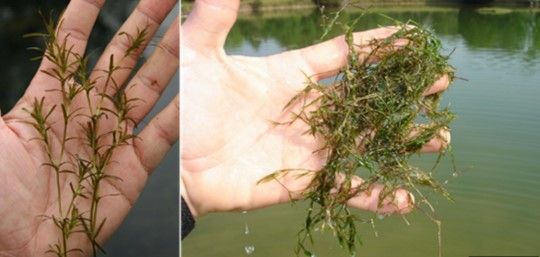
Credit: Robert Vidéki, Doronicum Kft., and Graves Lovell, Alabama Department of Conservation and Natural Resources, Bugwood.org
This Florida native species is found throughout the state, in all contiguous 48 US states, and in most of Canada. Southern naiad is characterized by many-branched stems, extremely narrow leaves (less than 1/16 inch), and teeth on leaf margins when observed under magnification. Inconspicuous green flowers bloom through the growing season. Although there are five species of Najas found in Florida, this species is the most common. Ducks and waterfowl eat the seeds, stems, and leaves of southern naiad, which rarely reaches nuisance levels. More recent surveys suggest that this species is present in small amounts in Lake Apopka, but surveys from decades ago describe it as more abundant.
Floating Plants
Floating plants are a category of aquatic plants that include free-floating and floating-leaved plants. Free-floating plants are not anchored into the sediment and retain nutrients from the water column. Floating-leaved plants are typically rooted in the sediment and utilize leaves that float nearly exclusively on the surface of the water (submersed aquatic plants may have submersed as well as floating leaves). Floating plants (both free-floating and floating-leaved) are generally seen lakeward of emergent species and are useful for protection from shoreline erosion and habitat creation. These types of plants can be especially concerning for lake managers, because navigation and recreation can be limited by vegetation on the lake surface. Lake Apopka has both native and nonnative floating plants that are present in small areas protected from wave action.
Common Duckweed (Lemna minor)
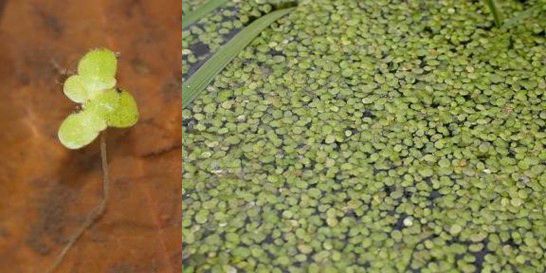
Credit: Jon Sullivan, CC BY-NC 2.0, and Matt Lavin, CC-BY-SA 2.0, North Carolina Extension Gardener Plant Toolbox
This aptly named plant provides food and habitat for ducks, as well as invertebrate food sources, and ducks often disperse duckweed from one water body to another. Duckweed has small (1/16 inch or smaller), flat leaves, and it clusters in large mats in slow-moving water areas. All duckweed species have a single root, a characteristic that distinguishes them from related species such as nonnative Landoltia. Reproduction is primarily asexual, with plants forming long chains of new stems from vegetative buds. Although common duckweed is native, it can be aggressive and cover the surface of the water. This species is commonly present in open-water areas.
Cone-Spur Bladderwort (Utricularia gibba)
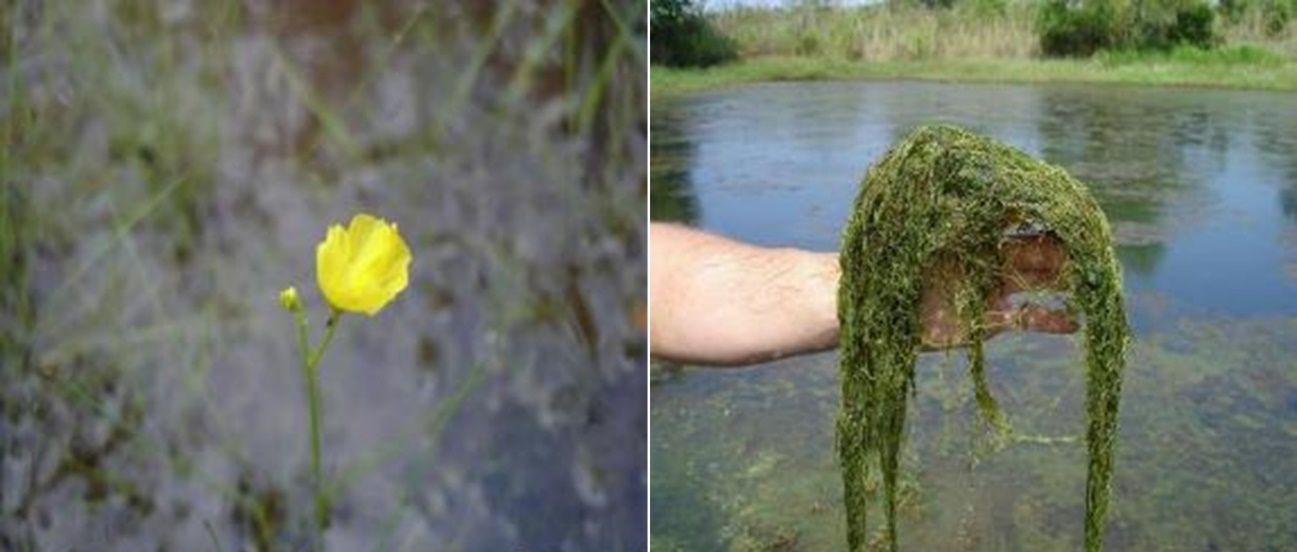
Credit: Graves Lovell, Alabama Department of Conservation and Natural Resources, Bugwood.org
Cone-spur bladderwort is a rootless and free-floating plant with sparse, extremely segmented leaves that appear bushy underwater. Showy two-lipped yellow flowers are borne atop a tall pedicel. The “cone-spur” name comes from small spurs on the pedicels below the flowers. Small, spherical carnivorous bladders occur on leaves underwater and trap aquatic prey. Cone-spur bladderwort occurs in open water and still areas, forming floating mats. Many types of wildlife use this species as shelter, including turtles and frogs, and it also provides forage for waterfowl.
Fragrant Water Lily (Nymphaea odorata)

Credit: Ann Murray, UF/IFAS Center for Aquatic and Invasive Plants
Fragrant water lily is a floating aquatic plant that can be found throughout Florida in ponds, lakes, and slow-moving streams. This water lily has fragrant white flowers (compare to yellow water lily below) and notched circular leaves that float on the surface of water, connected to rhizomes by a long, sturdy petiole. The leaves have a leathery purple underside and a shiny green upper surface with fine veins and air pores. The seeds, flowers, and leaves of this species are edible to humans, and its flowers are attractive to butterflies butpollinated by beetles. Fragrant water lily is frequently seen in some parts of Lake Apopka.
Yellow Water Lily (Nymphaea mexicana)

Credit: Ann Murray, UF/IFAS Center for Aquatic and Invasive Plants
Yellow water lily is an aquatic plant with bright-yellow flowers and rounded leaves that float on the surface of ponds, lakes, streams, and rivers. When this plant becomes crowded, the leaves may rise above the water. It is native to Florida (it was first described in Mexico, to which the Latin name refers) and can be found in water bodies throughout Florida and in the US southeast. The tubers of this species are an important food for ducks and can sometimes resemble a cluster of bananas. Yellow water lily commonly occurs in Lake Apopka.
Spatterdock (Nuphar advena)
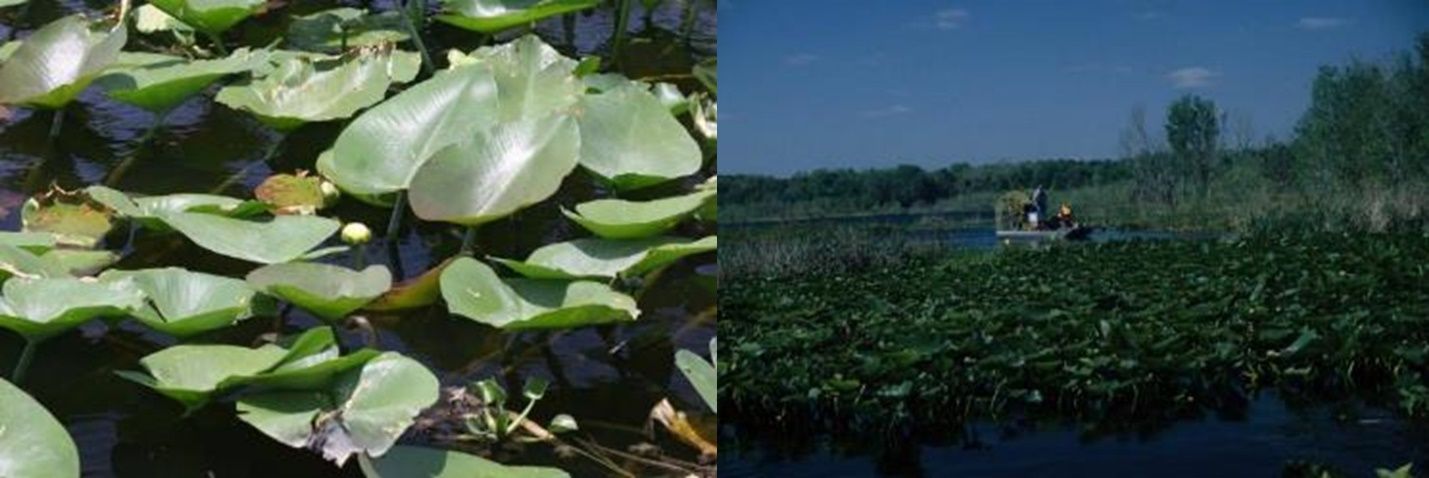
Credit: Vic Ramey, UF/IFAS Center for Aquatic and Invasive Plants
Spatterdock is a very common Lake Apopka species, forming dense mats in shallow areas. Arrow-shaped leaves (sometimes resembling elongated hearts) with wavy margins are attached to stout, strong stems that arise from spongy rhizomes rooted below the surface. A deep cut by the leaf base differentiates this species from other floating-leaved plants. Blooming from spring to summer, spatterdock has spheroidal-shaped flowers containing numerous yellow petals. Flowers are often described as “half open,” seen in a cup shape at or above the water surface. Reproduction occurs through horizontally spreading rhizomes or seed heads that sink to the bottom and germinate in circular colonies. Waterfowl are known to feed on small seeds as a secondary food source. Bluegill and red-eared sunfish fisheries are supported by this species because it is a host plant for the common bonnet worm, a major source of food. Because of these benefits, spatterdock is commonly planted for restoration purposes, as it is in Lake Apopka (Slagle and Allen 2018).
Water Fern (Salvinia minima)

Credit: Vic Ramey and Ann Murray, UF/IFAS Center for Aquatic and Invasive Plants
Water fern is a floating plant that grows together with other aquatic plants. Its joined oval leaves are ¾ inch wide with obvious stiff hairs. Although this species has no true roots, it does have modified leaf structures that grow under the water surface and are about 4 inches long. This species is common in Lake Apopka in still-water areas and occurs in association with duckweed species in open-water areas. Water fern is classified as a Category I invasive species, meaning that it alters native plant communities by displacing native species, causing considerable ecological damage (FISC 2019).
Water Hyacinth (Eichhornia crassipes)
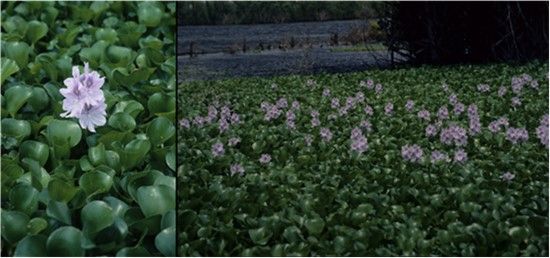
Credit: Vic Ramey and Ann Murray, UF/IFAS Center for Aquatic and Invasive Plants
Water hyacinth is a noxious floating plant that can vary in size from a few inches to over three feet tall. It is currently on the Florida Noxious Weed List. Native to Brazil, water hyacinth has elliptic, leathery leaf blades that are attached to spongy and inflated petioles. Beneath this plant are numerous dark roots that branch out into the water column. The inflorescence is a terminal spike that produces light-blue to violet flowers. This species either reproduces by vegetative means or through seeds that sink to the lake bottom. These seeds can remain dormant in periods of stress (such as drought) and will often germinate once ideal conditions return. Water hyacinths cause a huge environmental and economic problem around Florida. Through its dominance, this floating plant can clog waterways, reduce water quality by blocking sunlight, and reduce biodiversity. Populations of water hyacinth have the capability of doubling in size in less than 2 weeks. Because this is such a concerning species, it is regularly managed through chemical, physical, mechanical, and biological control. As for wildlife utilization, some invertebrate species (namely mosquitoes) utilize the fibrous root system as nesting habitat. Whatever slight benefits can be attributed to this species are vastly overshadowed by the drawbacks of this noxious plant, which is a management challenge in Lake Apopka. Water hyacinth is classified as a Category I invasive species, meaning that it alters native plant communities by displacing native species, causing considerable ecological damage (FISC 2019).
Water Lettuce (Pistia stratiotes)

Credit: Ann Murray, UF/IFAS Center for Aquatic and Invasive Plants
Although the native distribution of water lettuce is unclear, this aquatic herb is known to invade Florida aquatic systems and can be found statewide. Water lettuce has thick, light-green, water-repellant leaves with wavy margins and short hairs. The leaves are arranged in a floating rosette at the plant’s base, from which long, feathery roots hang in the water below. Water lettuce spreads rapidly to form dense mats, which can clog and restrict the usage of waterways as well as disrupt other plant and animal communities. Water lettuce is a prohibited aquatic plant on the Florida Noxious Weed list and is classified as a Category I invasive species, meaning that it alters native plant communities by displacing native species, causing considerable ecological damage (FISC 2019).
Water Pennywort (Hydrocotyle ranunculoides and Hydrocotyle umbellata)
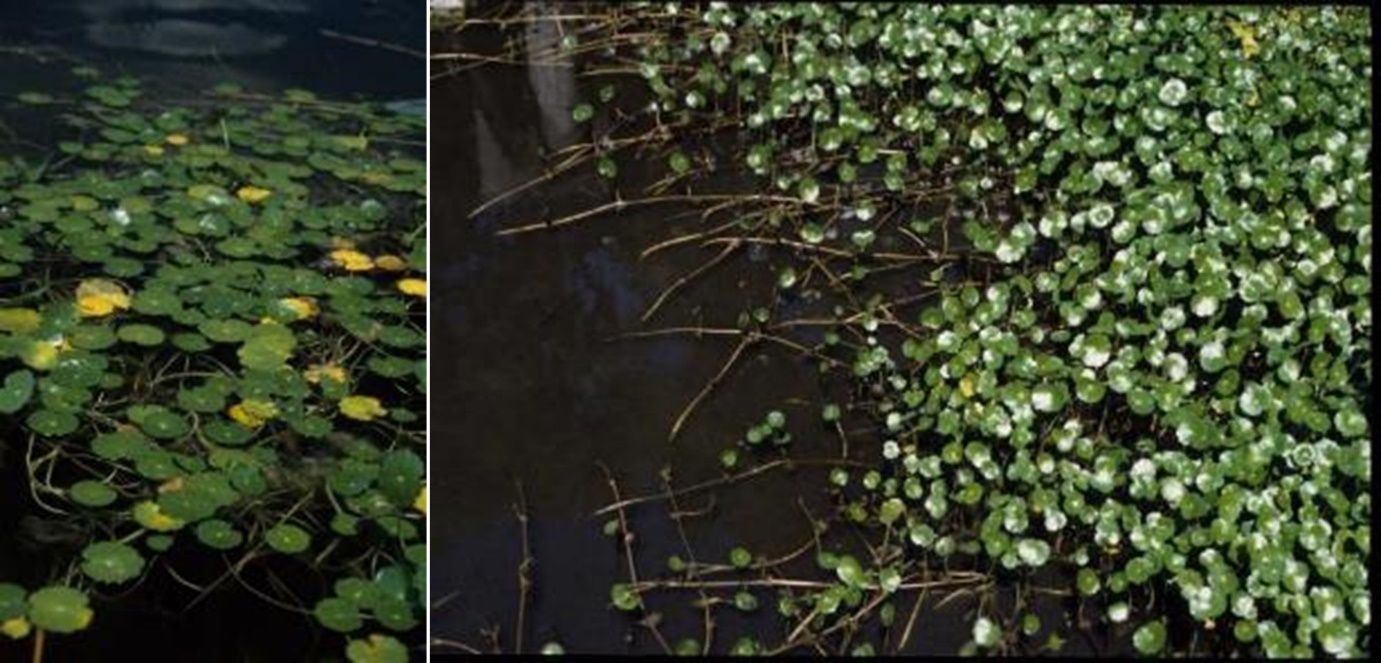
Credit: Vic Ramey and Ann Murray, UF/IFAS Center for Aquatic and Invasive Plants
Water pennyworts are very common in Lake Apopka and throughout the state. These species are unique in that they can be found as a terrestrial species along the edge of the water, rooted and floating within shallow portions, or free floating if a mat breaks loose. Pennyworts are characterized by their long stems, up to a foot long, and half-dollar sized, leathery, circular, and shiny green leaves that create dense mats. Leaf margins have blunted teeth around the edge of an umbrella-like pad. The two species of water pennywort are distinguished by leaf shape: Hydrocotyle umbellata leaves are entirely circular, while Hydrocotyle ranunculoides leaves are deeply notched. Flowering is year-round, and it is not uncommon to see white/greenish flowers bundled in delicate clusters. Waterfowl eat both the seeds and foliage of water pennyworts.
Conclusions
Knowledge of current plant communities can help guide restoration efforts, design management plans, and increase recreational experiences in natural areas. This resource will help generate familiarity with the plant species that characterize the culturally and ecologically significant habitats of Lake Apopka. By highlighting significant plant species here, we support the goal of increasing recognition and enjoyment of this key natural resource of the state of Florida.
Glossary of Botanical Terms
Bract: Modified, usually small, leaflike structure often positioned beneath a flower or inflorescence.
Corm: A bulbous stem part that is firm-fleshed and subterranean and produces aerial stems, leaves and flowers.
Emergent wetland plants: Aquatic plants that are rooted in sediment but have leaves at or above the water surface; they occur along the shoreline and shallower zone of lakes.
Floating plants: Plants with leaves that float on the water surface and may be rooted in sediment or not rooted and floating in the water column.
Inflorescence: A structure with multiple individual flowers.
Lance: A leaf shape resembling a lance (sword), generally several times longer than wide, broadest toward the base and tapering toward the leaf tip.
Leaf margin: The edge of a leaf.
Leaflet: A segment of a compound leaf.
Lobe: A usually rounded or pointed projecting part, typically one of two or more, each separated by a fissure or sinus.
Macrophyte: A plant, large enough to be visible to the naked eye, and a term commonly used to describe aquatic plants.
Panicle: An inflorescence in which the flowers are borne on branches of the main axis or on further branches of these.
Pedicel: The stalk of an individual flower.
Peltate: The point of attachment is the underside of the leaf as opposed to the margin.
Petiole: The stalk that attaches a leaf blade to a stem.
Rhizome: A stem, usually prostrate, that is growing below the ground surface.
Scape: The stemlike flowering stalk of a plant.
Segmented: Having free or almost free parts or subdivisions of an organ (e.g., leaves, flowers).
Serrated: Toothed so as to resemble a saw with teeth pointing forward.
Shrub: Woody plant typically less than 20 feet tall with many stems; in aquatic and wetland environments they colonize terrestrial brush and higher-elevation features.
Spike: A flower (or fruit) arrangement that has grouped flowers that are directly attached to a stem.
Spikelet: An often small unit of an inflorescence (flower cluster) typical of grasses, sedges, and other monocots.
Stolon: Creeping, horizontal aboveground plant stem or runner that takes root at points along its length to form new plants.
Submersed aquatic plants/submersed aquatic vegetation: Plants that have stems and leaves growing entirely underwater, may have floating leaves, and occur in deeper zones, rooted to the lake bottom; also abbreviated as “SAV.”
Tuber: A stem, usually underground, enlarged as a storage organ.
Whorl: A ringlike arrangement of similar parts (e.g., leaves, flowers, branches) arising from a common point or node.
Acknowledgments
This work was supported by the St. John’s River Water Management District (contracts 30247, and 31945). We thank Megz Keathly and Alex Matys for technical support.
Works Cited
Bowen, P., and J. Slater. 2016. Lake Apopka North Shore Biological Assessment for Phase 2 West Active Management Phase. St. Johns River Water Management District.
Center, T. D., J. P. Cuda, M. Grodowitz, and C. Minteer. 2022. “Alligatorweed Flea Beetle Agasicles hygrophila Selman and Vogt (Coleoptera: Chrysomelidae: Halticinae).” EDIS 2022 (1). https://edis.ifas.ufl.edu/publication/IN831
Chesnut, T. L., and E. H. Barman. 1974. “Aquatic Vascular Plants of Lake Apopka, Florida.” Fla. Sci. 37:60–64.
Clugston, J. P. 1963. “Lake Apopka, Florida: A Changing Lake and Its Vegetation.” Q. J. Fla. Acad. Sci. 26:168–174.
Conrow, R., E. F. Lowe, M. F. Coveney, R. H. Rauschenberger, and G. Masson. 2011. “Restoration of Lake Apopka’s North Shore Marsh: High Hopes, Tough Times, and Persistent Progress.” In Wildlife Ecotoxicology, edited by J. E. Elliott, C. A. Bishop, and C. A. Morrissey, 189–211. New York: Springer. https://doi.org/10.1007/978-0-387-89432-4_6
Coveney, M. F., E. F. Lowe, L. E. Battoe, E. R. Marzolf, and R. Conrow. 2005. “Response of a Eutrophic, Shallow Subtropical Lake to Reduced Nutrient Loading.” Freshw. Biol. 50 (10): 1718–1730. https://doi.org/10.1111/j.1365-2427.2005.01435.x
Dunne, E. J., M. F. Coveney, V. R. Hoge, R. Conrow, R. Naleway, E. F. Lowe, L. E. Battoe, and Y. Wang. 2015. “Phosphorus Removal Performance of a Large-Scale Constructed Treatment Wetland Receiving Eutrophic Lake Water.” Ecol. Eng. 79:132–142. https://doi.org/10.1016/j.ecoleng.2015.02.003
Dunne, E. J., M. F. Coveney, E. R. Marzolf, V. R. Hoge, R. Conrow, R. Naleway, E. F. Lowe, and L. E. Battoe. 2012. “Efficacy of a Large-Scale Constructed Wetland to Remove Phosphorus and Suspended Solids from Lake Apopka, Florida.” Ecol. Eng. 42:90–100. https://doi.org/10.1016/j.ecoleng.2012.01.019
Enloe, S. F., L. A. Gettys, J. Leary, and K. A. Langeland. 2012. “Hydrilla Management in Florida Lakes.” EDIS 2012 (3). https://doi.org/10.32473/edis-ag370-2012
FISC. 2019. List of Invasive Plant Species. Florida Invasive Species Council.
Florida Department of Agriculture and Consumer Services, Division of Plant Industry. 2022. "Florida Noxious Weed List." Accessed January 18, 2022. https://www.flrules.org/gateway/ChapterHome.asp?Chapter=5B-57
Florida Natural Areas Inventory (FNAI). 2010. FNAI Natural Community Classification Guide. Florida Natural Areas Inventory, Tallahassee, FL.
Gettys, L. A., and S. F. Enloe. 2016. “Hydrilla: Florida's Worst Submersed Weed.” EDIS 2016 (3): 7. https://journals.flvc.org/edis/article/view/127808
Iannone III, B. V., E. C. Bell, S. Carnevale, J. E. Hill, J. McConnel, M. Main, S. F. Enloe, S. A. Johnson, J. P. Cuda, S. M. Baker, and M. Andreu. 2021. “Standardized Invasive Species Terminology for Effective Outreach Education.” EDIS 2021 (4): 8. https://doi.org/10.32473/edis-fr439-2021
Ji, G., and K. Havens. 2019. “Periods of Extreme Shallow Depth Hinder but Do Not Stop Long-Term Improvements of Water Quality in Lake Apopka, Florida (USA).” Water 11 (3): 538. https://doi.org/10.3390/w11030538
Lieurance, D., and L. Gettys. 2019. “Lost in the Weeds?: A Comprehensive Guide to Florida’s Many Non-Native Plant Lists.” EDIS 2019 (5): 6. https://doi.org/10.32473/edis-ag436-2019
Looby, A., L. K. Reynolds, C. R. Adams, and C. W. Martin. 2021. “Submerged Aquatic Vegetation Patch Size Affects Fish Communities in a Turbid-Algal Lake.” Front. Conserv. Sci. 2:657691. https://doi.org/10.3389/fcosc.2021.657691
Looby, A., L. K. Reynolds, C. R. Adams, S. J. Walsh, and C. W. Martin. 2021. “Submerged Aquatic Vegetation Habitat Use of Age-0 Florida Bass Micropterus floridanus.” Environ. Biol. Fishes 104:947–958. https://doi.org/10.1007/s10641-021-01126-3
Moore, K., L. Fisher, C. Della Torre III, and L. Gettys. 2015. “Native Aquatic and Wetland Plants: Duck Potato, Sagittaria lancifolia.” EDIS 2016 (1): 3. https://doi.org/10.32473/edis-ag403-2015
Murphy, S. 2005. “Assessment of Fish and Plant Communities in Lake Apopka, Florida.” MS thesis, University of Florida.
Reynolds, L., C. R. Adams, E. Latimer, C. W. Martin, C. Rohal, and J. Slater. 2020. “A Comparison of Planting Techniques for Submerged Aquatic Vegetation.” EDIS 2020 (4). https://doi.org/10.32473/edis-ss685-2020
Reynolds, L. K., C. B. Rohal, W. A. Scheffel, C. R. Adams, C. W. Martin, and J. Slater. 2021. “Submerged Aquatic Vegetation Species and Populations within Species Respond Differently to Environmental Stressors Common in Restorations.” Environ. Manage. 68:477–490. https://doi.org/10.1007/s00267-021-01517-3
Rohal, C., L. K. Reynolds, C. Reinhardt Adams, and C. Martin. 2020b. “Pondweeds of Florida.” EDIS 2020 (5). https://doi.org/10.32473/edis-ss686-2020
Rohal, C. B., L. K. Reynolds, C. R. Adams, C. W. Martin, E. Latimer, S. J. Walsh, and J. Slater. 2020a. “Biological and Practical Tradeoffs in Planting Techniques for Submerged Aquatic Vegetation.” Aquat. Bot. 170:103347. https://doi.org/10.1016/j.aquabot.2020.103347
Slagle, Z. J., and M. S. Allen. 2018. “Should We Plant Macrophytes? Restored Habitat Use by the Fish Community of Lake Apopka, Florida.” Lake Reserv. Manag. 34 (3): 296–305. https://doi.org/10.1080/10402381.2018.1443179
Tootoonchi, M., L. A. Gettys, and J. H. Bhadha. 2019. “Tapegrass, Eelgrass, or Wild Celery (Vallisneria americana Michaux): A Native Aquatic and Wetland Plant.” EDIS 2019 (5). https://doi.org/10.32473/edis-ag437-2019
UF/IFAS Center for Aquatic and Invasive Plants. 2021. “Plant Directory.” https://plants.ifas.ufl.edu/plant-directory/
UF/IFAS Lakewatch Program. 2020. Lakewatch Data. University of Florida.
United States Government Publishing Office. 1975. "The Federal Noxious Weed Act." Accessed October 26, 2022. https://www.govinfo.gov/content/pkg/STATUTE-88/pdf/STATUTE-88-Pg2148.pdf
USDA, NRCS. 2018. “The PLANTS Database.” http://plants.usda.gov/
Wells, B., and C. Minteer. 2022. “Alligatorweed Stem Borer (suggested common name) Arcola malloi Pastrana (Insecta: Lepidoptera: Pyralidae: Phycitinae).” EDIS 2021 (1): 4. https://doi.org/10.32473/edis-in1300-2020
Table 1. Plants commonly observed in Lake Apopka in the lake and along the immediate lakeshore (UF/IFAS Lakewatch Program, 2020, q = SJRWMD lake vegetation perimeter surveys and b = personal observations from 2019 to 2021). Species profiled in this publication are marked in the last column. (1 = FISC Category I: increased abundance causes significant ecological damage, 2 = FISC Category II: increased abundance causes some ecological damage, 3 = State of Florida Noxious Weed List, 4 =Federal Noxious Weed List * = nuisance species that can be a focus of management efforts).